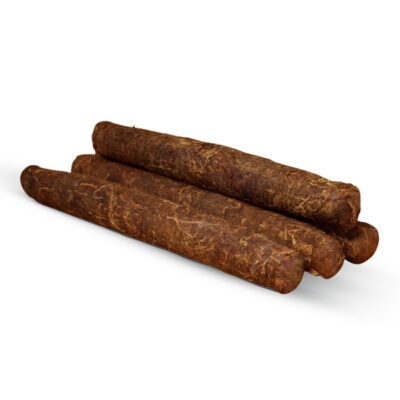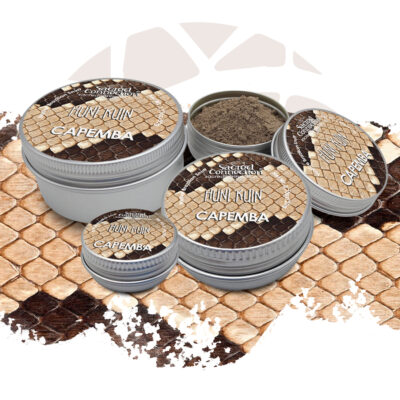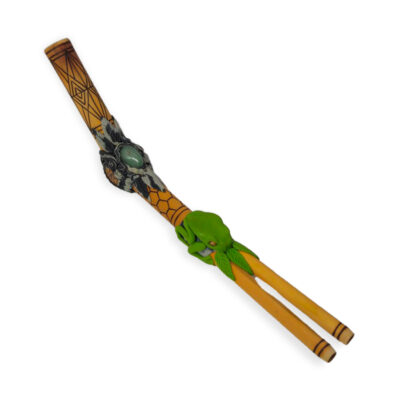Die Katukina
In den letzten Jahren haben wir eng mit dem Häuptling Fernando Katukina, dem Anführer seines Volkes, zusammengearbeitet. Wir haben dabei geholfen, Projekte in ihrer Gemeinde zu verwirklichen. Seine Familie hat uns mit Katukina-Medikamenten und Kunsthandwerk versorgt.
Zum großen Bedauern aller, die ihn kannten, ist er Anfang des Jahres verstorben. Wir arbeiten weiter mit seiner Familie zusammen.
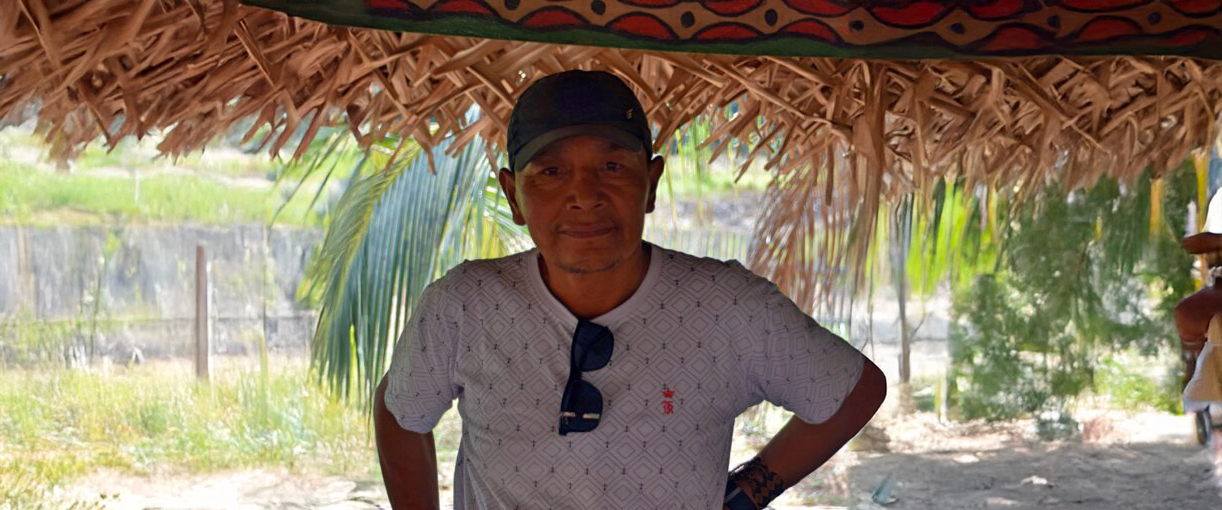
Die Katukina leben aufgeteilt auf zwei Stammesgebiete. Das erste ist der Gregório-Fluss, wo sie mit den Yawanawa leben, mit denen sie viele familiäre Verbindungen haben. Das zweite ist der Campinas-Fluss, in der Nähe von Cruzeiro do Sul. Interessant ist, dass sie, obwohl sie in der Nähe der Straße leben, mit all den äußeren Einflüssen, die diese mit sich bringt, ihre Sprache noch intakt haben.
Fast alle Pano-Stämme, mit Ausnahme der Huni Kuin, haben den größten Teil ihrer Sprache verloren, und die Jugend spricht kaum noch etwas. Die Katukina hingegen sprechen hauptsächlich ihre eigene Pano-Sprache und lernen Portugiesisch erst im Alter von etwa acht Jahren. Viele der Frauen und Älteren sprechen kaum Portugiesisch.
Name
Es ist nicht einfach, die Katukina allein anhand ihres Namens zu bestimmen. Seit der ersten Hälfte des 19. Jahrhunderts werden in den historischen Aufzeichnungen von Missionaren, Reisenden und Regierungsvertretern über die indigenen Völker des Juruá-Flusses alle bekannten indigenen Gruppen mit dem Namen Katukina bezeichnet. Dem Anthropologen Paul Rivet zufolge ist "Katukina" - oder Catuquina, Katokina, Katukena, Katukino - ein Gattungsbegriff, der fünf sprachlich unterschiedliche und geografisch nahe gelegene Gruppen bezeichnete (Rivet 1920). Heute sind es nur noch drei: eine aus der Katukina-Sprachfamilie in der Region des Jutaí-Flusses im Bundesstaat Amazonas und zwei aus der Pano-Sprachfamilie im Bundesstaat Acre.
Keine der beiden Pano-Gruppen, die unter dem Namen "Katukina" bekannt sind, erkennt das Wort als Selbstbezeichnung an. Die Mitglieder der einen Gruppe, die an den Ufern des Flusses Envira in der Nähe der Stadt Feijó leben, ziehen es vor, als Shanenawa bezeichnet zu werden, ihr eigener Name für sich selbst. Die Angehörigen der anderen Gruppe erkennen in ihrer eigenen Sprache keine Bedeutung von "Katukina", haben es aber dennoch übernommen und sagen, dass die Bezeichnung "von der Regierung vergeben" wurde.
Dieser Text bezieht sich nur auf die letztgenannte Gruppe. Der Name "Katukina" wurde von den Angehörigen ihrer beiden Dörfer an den Flüssen Campinas und Gregório akzeptiert, die keine gemeinsame ethnische Bezeichnung haben. Die einzigen Selbstbezeichnungen, die allgemein akzeptiert werden, beziehen sich auf die sechs Clans, in die sie sich aufteilen: Varinawa (Volk der Sonne), Kamanawa (Volk des Jaguars), Satanawa (Volk der Otter), Waninawa (Volk der Pfirsichpalme), Nainawa (Volk des Himmels) und Numanawa (Volk der Taube). Es ist bemerkenswert, dass diese Bezeichnungen mit Ausnahme der Nainawa mit den Namen einiger Gruppen des Marúbo-Volkes identisch sind.
Katukina Sprache
Die Katukina-Sprache gehört zur Pano-Sprachfamilie. Die Nasalierung ist eines ihrer bemerkenswerten Merkmale. Die meisten Wörter sind zweisilbig und oxytonisch, und neue Wörter werden durch Kombination von zwei Wörtern oder durch Hinzufügen eines oder mehrerer Suffixe gebildet. Bei den Personalpronomen wird nicht zwischen den Geschlechtern unterschieden. Alle Katukina sprechen ihre eigene Sprache, wenn sie sich untereinander unterhalten. Portugiesisch wird nur verwendet, um sich mit Nicht-Indianern zu unterhalten. Trotz des langen Kontakts mit diesen spricht weniger als die Hälfte der Katukina-Bevölkerung fließend Portugiesisch.
Die Sprache der Katukina an den Flüssen Campinas und Gregório unterscheidet sich deutlich von der Sprache der Shanenawa.
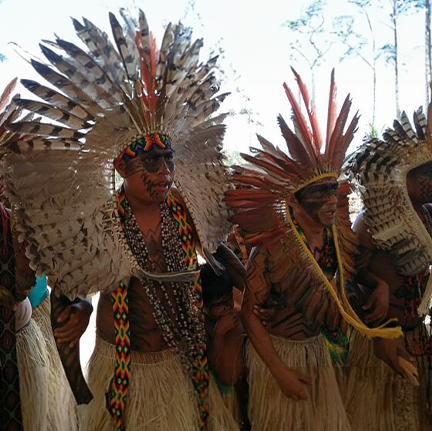
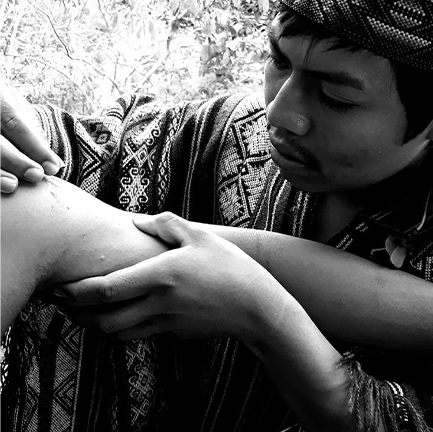
Geschichte des Kontakts mit den Weißen
Wie die anderen indigenen Gruppen der oberen Juruá-Region waren auch die Katukina praktisch eingekreist, als um 1880 die wirtschaftliche Erschließung der Region mit der Gewinnung von einheimischem Kautschuk begann. Das von ihnen bewohnte Gebiet, das reich an Eukalyptusbäumen (Castilloa elastica) und Kautschukbäumen (Hevea brasiliensis) ist, wurde schnell von Peruanern und Brasilianern erobert, die von entgegengesetzten Seiten ihres Territoriums kamen.
Die Anwesenheit der ersteren war nur von kurzer Dauer, da sie auf der Suche nach Gummi waren, einem Produkt, das durch das Abholzen der Bäume gewonnen wurde, die infolgedessen schnell abgeholzt wurden. Im Gegensatz dazu ließen sich die brasilianischen Kautschukzapfer dauerhaft in dem Gebiet nieder, da die regelmäßigen oberflächlichen Schnitte in den Stamm der Hevea brasiliensis die Gewinnung von Kautschuk über einen langen Zeitraum ermöglichten.
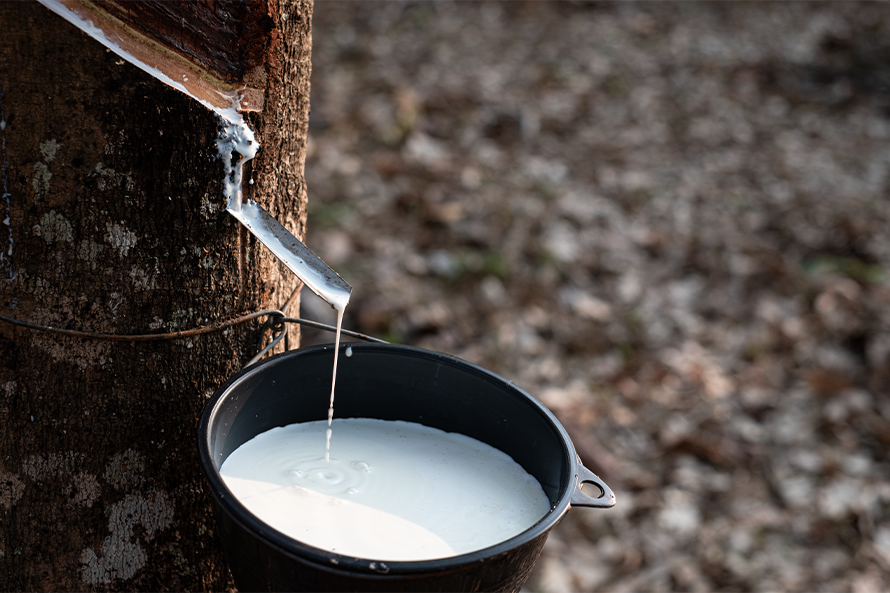
Die Katukina erlebten in den ersten Jahren ihres Kontakts mit den Weißen eine Zeit ständiger Umzüge, um den von den peruanischen Gummiextraktoren und brasilianischen Kautschukzapfern organisierten "correrias" lebend zu entkommen - Überfälle, die darauf abzielten, die indigene Bevölkerung auszulöschen, um ungehinderten Zugang zu den Kautschukbäumen zu bekommen. Auf der Flucht vor den Correrias wurden die Katukina über die gesamte Region verstreut. Da sie nicht in der Lage waren, als Gruppe zusammenzubleiben, verstreuten sie sich im Wald und ernährten sich von Wild, wilden Pflanzen und Überfällen auf die Plantagen, auf die sie auf ihren Reisen stießen, da sie nicht mehr in der Lage waren, ihre eigenen Sümpfe anzulegen, die die Weißen unweigerlich zu ihnen geführt hätten. Darüber hinaus wurden die ständigen Umzüge auch durch den Glauben angetrieben, dass die Geister der Toten, die sich nach ihren Verwandten sehnten, auf die Erde kommen könnten, um die Lebenden zu suchen.
Die Correrias kamen im ersten Jahrzehnt des 20. Jahrhunderts zum Erliegen, was zum Teil auf die Erschöpfung der gefällten Gummibäume, aber auch auf die Grenzkonflikte zwischen Brasilien und Peru zurückzuführen war, die 1909 vertraglich beigelegt wurden. Der Verfall des Kautschukpreises auf dem internationalen Markt im Jahr 1912 trug ebenfalls zur Einstellung der Correrias bei. Auch wenn diese Zeiten vorbei sind, haben die Katukina noch schreckliche Erinnerungen an diese Ereignisse, die ihnen von ihren Eltern und Großeltern überliefert wurden, Erinnerungen, die von Fluchten und Trennungen im Wald erzählen, voller Bilder von verstümmelten Leichen und geprägt von Gewalt.
Als die Region von Nicht-Indianern bevölkert wurde, erlebten die Katukina eine drastische Verringerung sowohl ihres Lebensraums als auch ihrer Bevölkerung - und hier müssen wir auch die Bevölkerungsverluste aufgrund von Krankheiten berücksichtigen, die es bei ihnen früher nicht gegeben hatte. Die Katukina hatten keine andere Wahl, als in der Kautschukgewinnung zu arbeiten, blieben aber über die ganze Region verstreut, da es üblich wurde, dass sich jede Kernfamilie in einer anderen Kautschukzone niederließ, um dort zu arbeiten. Dies führte natürlich zu einem Bruch in ihrer Gesellschaft, da sie nicht mehr in der Lage waren, ihr Leben nach ihren eigenen Prinzipien und soziokulturellen Werten zu organisieren und zu teilen.
Bei diesem Hin und Her zwischen Flüssen und Kautschukgebieten war der Bezugspunkt immer der Fluss Gregório, genauer gesagt die Kautschukplantage Sete Estrelas (Sieben Sterne), ein Ort, an den die Katukina nach unterschiedlichen Zeiträumen an verschiedenen Orten immer wieder zurückkehrten. Die Wanderungen von einem Fluss oder Kautschukgebiet zum anderen sind Teil der Erinnerung der Katukina. Die wichtigsten Gebiete, die sie durchwanderten, waren die Kautschukplantagen Sete Estrelas und Cashinahua am Fluss Gregório, Universo am Tarauacá sowie Guarani und Bom Futuro am kleineren Fluss Liberdade.
In den 1950er Jahren kam es zu einer Unterbrechung der ständigen Auseinandersetzungen, und die meisten der Katukina - wenn auch nicht alle - wurden auf der Kautschukplantage Sete Estrelas wieder zusammengeführt. Im folgenden Jahrzehnt spaltete sich die Gruppe zum einen aufgrund von Missverständnissen zwischen den Katukina, ihrem Häuptling und dem neuen Besitzer der Kautschukplantage, für den sie arbeiteten, und zum anderen aufgrund von Streitigkeiten mit den Yawanawá, einer benachbarten Pano-Indigenengruppe vom Gregório-Fluss, zu der die Beziehungen stets zwischen offener Feindseligkeit und zurückhaltender Freundschaft geschwankt hatten. Auf der Suche nach einem neuen Chef und aus Sorge vor den drohenden Konflikten mit den Yawanawá beschloss ein Teil der Gruppe, sich einen anderen Lebensraum zu suchen. Sie ließen sich schließlich für etwa acht Jahre auf einer Kautschukplantage in der Nähe der Mündung des kleineren Flusses Liberdade an der Grenze zwischen den Bundesstaaten Acre und Amazonas nieder.
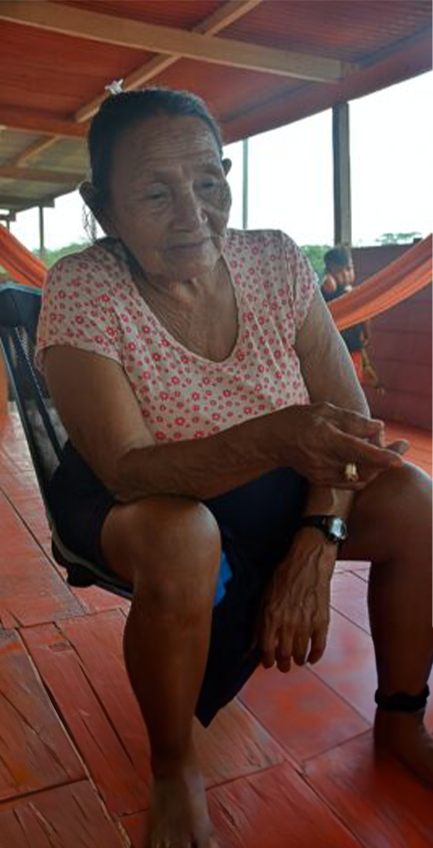
Erst Mitte der 1980er Jahre, nach vielen Jahren des Umherziehens und der Umsiedlung, wurde den Katukina ihr Recht auf den Besitz des Gebietes, in dem sie lebten, zugesichert, und sie lösten sich endgültig von den Banden, die sie an die Kautschukbosse gebunden hatten.
Kontakt mit anderen ethnischen Gruppen
Im Laufe ihrer Geschichte haben die Katukina mit verschiedenen indigenen Gruppen in der Region des Juruá-Flusses und in jüngerer Zeit auch mit anderen Gruppen aus dem Javari-Flussgebiet friedliche oder andere Kontakte gepflegt. Die Kulina, Yawanawá und Marúbo sind die drei Gruppen, mit denen die Katukina die intensivsten und bedeutendsten Kontakte hatten und haben.
Die Kontakte zwischen den Katukina und den Kulina - Sprechern einer Arawá-Sprache, die heute in Dörfern entlang der Flüsse Juruá und Purus in Brasilien und Peru leben - waren zumindest bis in die 1960er Jahre häufig. Die Mitglieder der beiden Gruppen trafen sich vor allem, um gemeinsam bestimmte Rituale durchzuführen. Heutzutage treffen sich die Katukina und die Kulina nicht mehr, da die beiden Gruppen aufgrund der wiederholten Umsiedlungen der Kulina heute weit voneinander entfernt leben. Die Katukina erinnern sich jedoch noch an die Lieder, die ihnen von den Kulina beigebracht wurden. Diese Lieder wurden in das musikalische Repertoire der Katukina aufgenommen, die sie auch heute noch singen, obwohl sie den Inhalt der Lieder nicht verstehen können.
Von den beiden Pano-Gruppen in der oberen Juruá-Region sind die Yawanawá die nächsten und ältesten Nachbarn der Katukina, mit denen sie sich derzeit das Gebiet am Gregório-Fluss teilen.
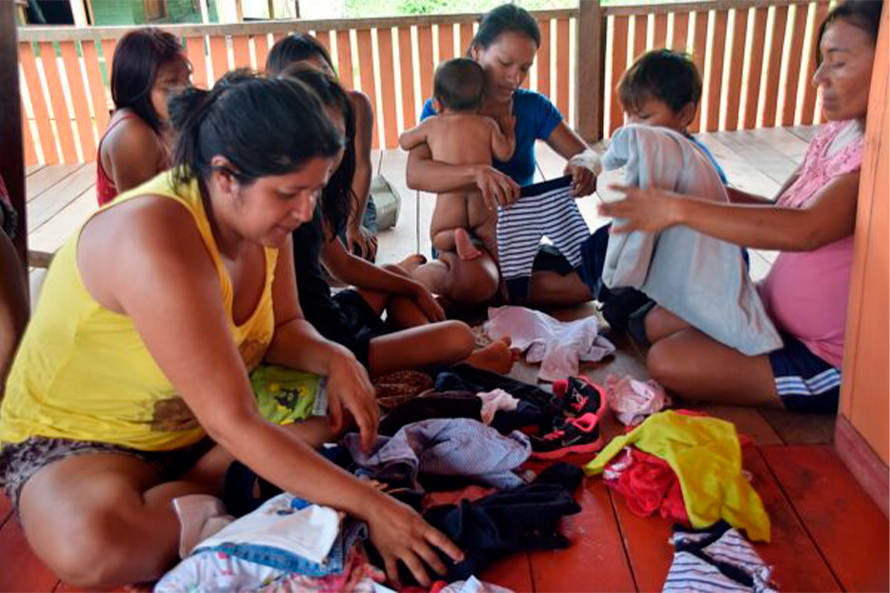
Die Yawanawá waren auch ihre hartnäckigsten Widersacher. Die Katukina beschuldigen die Yawanawá, in der Vergangenheit ihre Frauen entführt zu haben, und provozieren damit einen Krieg zwischen ihnen. Die ebenfalls häufigen Anschuldigungen wegen Zauberei halten bis heute an. Trotz der Rivalität stehen sich die Katukina und die Yawanawá nicht die ganze Zeit über gegenüber. Die gemeinsame Durchführung von Ritualen, Eheschließungen und gemeinsame Wohnsitze, sowohl in der Vergangenheit als auch in der Gegenwart, sind unter ihnen recht häufig. Ihre Beziehungen beruhen eher auf Ambivalenzen als auf reinen Gegensätzen. So sehr, dass die zahllosen Jahre der Rivalität sie nicht endgültig auseinander trieben, und in den 1980er Jahren schlossen sich die beiden Gruppen sogar zusammen, um eine gemeinsame Abgrenzung ihrer Gebiete zu fordern.
Die etwas weiter entfernten Marúbo haben ebenfalls regelmäßige Kontakte zu den Katukina unterhalten, allerdings erst in den letzten Jahren. Dennoch hat die kurze Zeit des engen Kontakts nicht verhindert, dass die Marúbo die Gruppe sind, mit der sich die Katukina heute am meisten identifizieren.
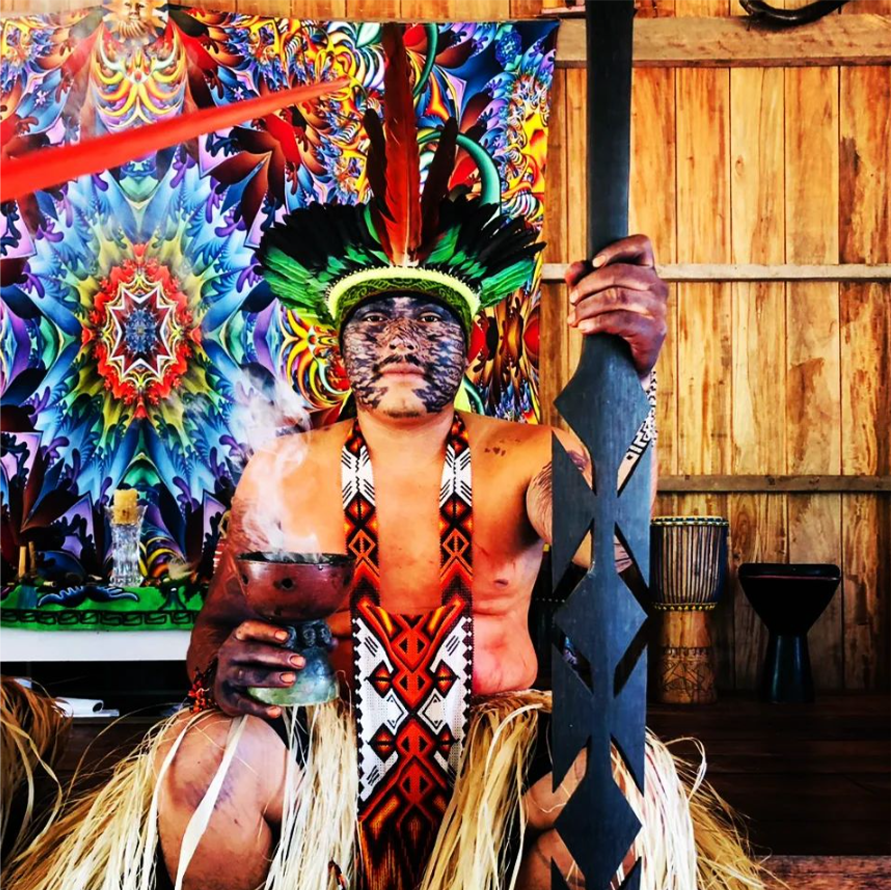
Die erste Begegnung zwischen den beiden Gruppen scheint in den 1980er Jahren stattgefunden zu haben, als Missionare des MNTB (die auch unter den Marúbo am Ituí-Fluss arbeiten) zwei am Gregório-Fluss lebende Katukina zu den Marúbo brachten. Dieses Treffen scheint jedoch zu nichts geführt zu haben. Zu einem engeren Kontakt zwischen den Katukina und den Marúbo kam es erst im folgenden Jahrzehnt, im Jahr 1992, nach einer zufälligen Begegnung im Hafen von Cruzeiro do Sul. Die Katukina gingen durch das Hafengebiet, als sie einige Leute hörten, die eine ähnliche Sprache wie sie sprachen, und beschlossen, sich ihnen zu nähern. Sie stellten sich vor, wechselten ein paar Worte und entdeckten bald, dass sie neben der Sprache noch andere Aspekte gemeinsam hatten. Die Hauptübereinstimmung bestand darin, dass einige der Marúbo auch als Satanawa, Varinawa, Kamanawa, Waninawa und Numanawa bezeichnet wurden. Bei dieser Begegnung tauschten sie eine Reihe von Geschenken aus und verabredeten sich für ein weiteres Treffen.
Nach dem Treffen in Cruzeiro do Sul besuchten zwei Katukina die Marúbo-Dörfer am Fluss Ituí, und fünf Marúbo besuchten das Dorf am Fluss Campinas. Auf der Grundlage dieser Besuche begannen die Katukina, über die Gemeinsamkeiten und Unterschiede zwischen ihnen und den Marúbo sowie über die Ursachen nachzudenken, die sie erklären könnten. Die wichtigste Schlussfolgerung war, dass die Marúbo in der Vergangenheit die gleiche Gruppe wie die Katukina bildeten. Die Trennung zwischen ihnen erfolgte jedoch zu einem Zeitpunkt, als weder die heutigen Katukina und Marúbo noch ihre Eltern und Großeltern geboren waren - also lange bevor sie zum ersten Mal auf die Weißen trafen.
Nach Ansicht der Katukina lassen sich ihre Ähnlichkeiten mit den Márubo auf verschiedene Weise nachweisen: Die Marúbo sind in mehrere Sektionen unterteilt, von denen einige die gleichen Bezeichnungen tragen wie ihre eigenen Clans; die Sprache der Marúbo ist der der Katukina sehr ähnlich; die Gemeinschaftshäuser, in denen die Marúbo leben, ähneln den Häusern, in denen sie selbst lebten, bevor sie mit den Weißen in Kontakt kamen. Die Katukina stimmen darin überein, dass die Form, in der die Marúbo heute leben, ihre eigene Lebensweise in der Vergangenheit repräsentiert und die Marúbo daher von ihnen als eine Proto-Katukina-Gesellschaft angesehen werden.
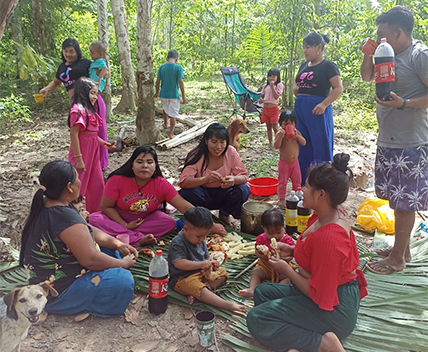
Die Katukina-Klans
Wie wir bereits gesehen haben, teilen sich die Katukina in sechs Clans auf: Varinawa, Kamanawa, Nainawa, Waninawa, Satanawa und Numanawa. Diese Clans sind nach dem Prinzip der Einheitlichkeit organisiert. Allerdings sind sich die Katukina hier uneinig: Während die einen Matrilinearität behaupten, behaupten andere Patrilinearität.
Unter den Katukina gibt es eine lebhafte Debatte darüber, welches Prinzip der Vereinheitlichung "richtig" ist. Auf der einen Seite behaupten die Befürworter der Matrilinearität, sie seien der Vergangenheit treuer. Auf der anderen Seite räumen die Verfechter der Patrilinearität offen ein, dass es in den letzten Jahren zu einer Umkehrung der Abstammungsregel gekommen ist.
Diese Diskussion wird von der Vorstellung beherrscht, dass es ein "richtiges" oder "reines" Prinzip gibt, das die traditionelle Ordnung zum Ausdruck bringt. Diejenigen, die die Abstammung entlang der mütterlichen Linie behaupten, suchen in der Vergangenheit nach einem Modell für diese Ordnung und führen unwiderlegbare Genealogien an, um das zu veranschaulichen, was sie für das Ideal halten. Diejenigen, die dies heute bestreiten, indem sie behaupten, die Katukina seien patrilinear, tun dies ebenfalls auf der Suche nach demselben Gefühl von "Reinheit" und Tradition. Allerdings mit einem wichtigen Detail: Das von ihnen gewählte Modell ist Cashinahua. Einige Katukina sagen, dass sie vor etwa fünfzehn Jahren entdeckt haben, dass die Cashinahua patrilinear sind.
Da man schon seit einiger Zeit nicht mehr sicher wusste, wie die "Alten" lebten, beschlossen einige dieser Katukina, die Patrilinearität nach dem Muster der Cashinahua zu übernehmen. Die Prämisse hinter dieser Anleihe ist klar: Wenn es keine konsistente und unbestreitbare einheimische "Regel" gibt, kann sie anderswo gefunden werden.
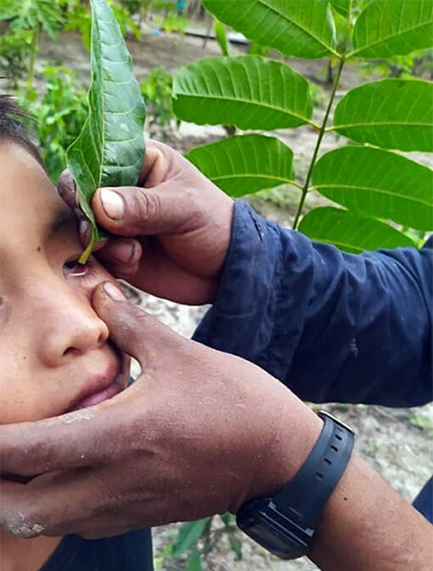
Die Frage, was letztlich das wahre Prinzip der Zugehörigkeit der Katukina-Gruppierungen ist, bleibt offen. Die Debatte unter ihnen bringt so unterschiedliche wie interessante Positionen hervor, denn ihr gemeinsamer Aspekt ist die Behauptung, dass sie im Kontakt mit den Weißen etwas verloren haben. Etwas, das nur durch eine Rückkehr zu ihrem früheren Selbst wiedergewonnen werden kann, wie es die Verfechter der matrilinearen Abstammung wünschen, oder durch die Suche nach dem Modell, das angeblich unter den Katukina bei anderen Pano-Völkern existierte, wie die Verfechter der patrilinearen Abstammung behaupten.
Obwohl die Regel der Abstammung insgesamt nicht definiert ist, ist es möglich, die internen Gruppierungen, aus denen sich die Gesellschaft der Katukina zusammensetzt, als Clans zu definieren, da den Katukina eine Idee zugrunde liegt, die man als "vermeintliche" oder "vermutete" Abstammung bezeichnen kann: Mit anderen Worten, die heutigen Varinawa werden als Nachkommen der alten Varinawa angesehen, die Kamanawa als Nachkommen der alten Kamanawa und so weiter.
Es ist vielleicht sinnvoller, bei den Selbstbezeichnungen der Katukina an einen "Clanifizierungsprozess" zu denken. Wie wir gesehen haben, war bei den Katukina, als sie sich der Patrilinearität der Cashinahua bewusst wurden, bereits ein gewisses Gefühl des Verlusts der traditionellen Organisation entstanden (das normalerweise dem Einfluss westlicher Werte zugeschrieben wird). Indem die Katukina auf eine dieser Formen der Rückverfolgung der Abstammung (mütterlicherseits oder väterlicherseits) zurückgreifen, verstärken sie einfach die Idee der "Ahnenschaft", ohne sie jedoch direkt mit anderen Ebenen der sozialen Organisation zu verbinden (wie es beispielsweise bei den Márubo der Fall ist).
Die Katukina waren einer der ersten Stämme, die die Medizin
des Waldes wie Kambo und Rapé auf
in die Außenwelt brachten, zunächst nach Brasilien und dann rund um den Planeten.


